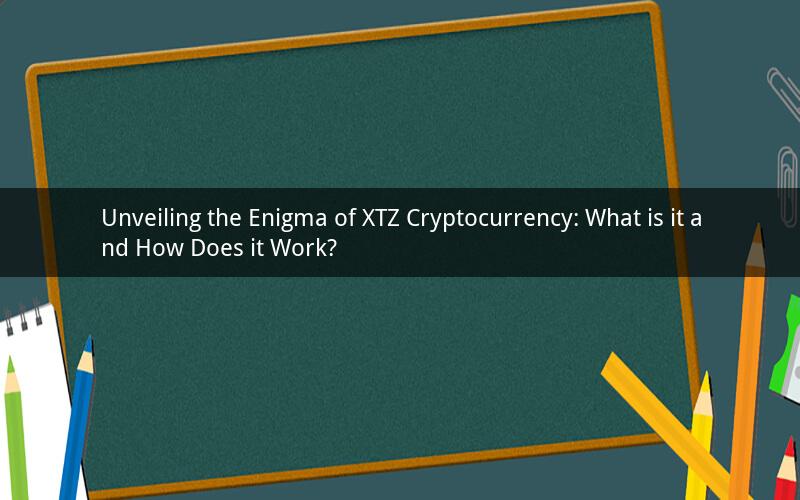
The cryptocurrency landscape is ever-evolving, with new coins and tokens emerging daily. One such coin that has gained attention in recent years is XTZ, the native cryptocurrency of the Tezos blockchain. But what exactly is XTZ cryptocurrency, and how does it function? This article delves into the intricacies of XTZ, exploring its origins, features, and potential future.
Origins of XTZ
XTZ was created by Arthur Breitman and Kathleen Breitman, along with a team of developers and advisors. The concept of Tezos was first introduced in a white paper published in 2014, outlining a new approach to blockchain technology that aimed to address some of the limitations of existing cryptocurrencies. In 2017, the Tezos Foundation was established to oversee the development and growth of the Tezos ecosystem.
Features of XTZ
1. Self-Amending Ledger: One of the unique features of Tezos is its self-amending ledger, which allows the blockchain to evolve and adapt without the need for a hard fork. This means that any changes to the protocol can be made through a democratic process, ensuring the long-term sustainability of the network.
2. Proof of Stake: XTZ operates on a proof-of-stake consensus mechanism, where validators are chosen based on the number of tokens they hold and are willing to "stake" as collateral. This incentivizes users to hold and secure the network, reducing the risk of centralization.
3. Smart Contracts: Tezos supports smart contracts, enabling developers to create decentralized applications (dApps) and decentralized finance (DeFi) projects. The platform's smart contracts are written in Michelson, a formal language designed for Tezos.
4. Cross-Chain Interoperability: Tezos aims to be interoperable with other blockchains, allowing for seamless transfers of assets and interactions between different networks. This can lead to increased adoption and integration of XTZ in various sectors.
5. Energy Efficiency: Compared to proof-of-work cryptocurrencies like Bitcoin, Tezos consumes significantly less energy, making it more environmentally friendly.
Potential Future of XTZ
The future of XTZ seems promising, considering its unique features and growing ecosystem. Here are some potential developments:
1. Increased Adoption: As more users and businesses recognize the benefits of Tezos, the demand for XTZ is likely to rise. This could lead to a surge in its price and wider adoption as a medium of exchange and store of value.
2. DApp Ecosystem Growth: With the increasing number of smart contracts and dApps on Tezos, the platform is expected to attract more developers and investors. This can lead to a thriving ecosystem of innovative projects.
3. Interoperability: As Tezos continues to improve its interoperability with other blockchains, it can become a crucial player in the cryptocurrency space, facilitating seamless cross-chain transactions and collaborations.
4. Regulatory Compliance: With the rise of regulatory scrutiny in the cryptocurrency industry, Tezos' self-amending ledger and proof-of-stake mechanism can help the platform remain compliant with evolving regulations, enhancing its long-term viability.
5. Community and Governance: The success of Tezos depends heavily on its community and governance structure. As the community continues to grow and participate in decision-making processes, the platform can become more resilient and adaptable to future challenges.
Frequently Asked Questions (FAQs) about XTZ Cryptocurrency
1. What is the difference between Tezos and Ethereum?
Tezos and Ethereum are both blockchain platforms that support smart contracts and dApps. However, Tezos has a self-amending ledger and proof-of-stake consensus mechanism, which make it more adaptable and energy-efficient compared to Ethereum's proof-of-work mechanism.
2. How does XTZ's proof-of-stake mechanism work?
XTZ's proof-of-stake mechanism allows validators to be chosen based on the number of tokens they hold and are willing to stake. Validators are responsible for validating transactions and securing the network, earning rewards in the process.
3. Can I mine XTZ?
No, XTZ cannot be mined. The proof-of-stake consensus mechanism makes mining unnecessary, as validators are chosen based on the number of tokens they hold and are willing to stake.
4. What is the current market cap of XTZ?
The market cap of XTZ fluctuates regularly due to market demand and supply. As of the latest data available, the market cap of XTZ is approximately $2.8 billion.
5. Can I use XTZ for everyday transactions?
Yes, XTZ can be used for everyday transactions, such as purchasing goods and services online or sending funds to friends and family. However, its adoption as a medium of exchange may vary depending on the specific use case and regulatory environment.